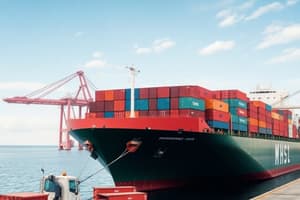Podcast
Questions and Answers
What is a key benefit of international trade agreements?
What is a key benefit of international trade agreements?
- Lower barriers to trade (correct)
- Reduce the number of shipping methods
- Increase shipping costs
- Complexify customs procedures
Which shipping method is known for being the most cost-effective?
Which shipping method is known for being the most cost-effective?
- Air transportation
- Rail transportation
- Sea transportation (correct)
- Land transportation
Why is it important to understand international trade agreements when exporting goods?
Why is it important to understand international trade agreements when exporting goods?
- To reduce shipping options
- To ensure compliance with guidelines (correct)
- To raise tariffs on imports
- To increase customs complexity
What is a disadvantage of air freight as a shipping method?
What is a disadvantage of air freight as a shipping method?
Which part of the export procedure ensures that goods reach their destination securely and timely?
Which part of the export procedure ensures that goods reach their destination securely and timely?
Why should businesses be aware of customs regulations when exporting goods?
Why should businesses be aware of customs regulations when exporting goods?
What is the main purpose of tariffs in the context of international trade?
What is the main purpose of tariffs in the context of international trade?
Which document is typically required for international exports to prove the place of origin of the goods?
Which document is typically required for international exports to prove the place of origin of the goods?
What can happen if a company fails to comply with customs regulations when exporting goods?
What can happen if a company fails to comply with customs regulations when exporting goods?
Which element is crucial to research before exporting goods to avoid unexpected expenses?
Which element is crucial to research before exporting goods to avoid unexpected expenses?
What is the primary function of an insurance certificate in the export process?
What is the primary function of an insurance certificate in the export process?
How do export taxes usually compare with import tariffs in terms of rates?
How do export taxes usually compare with import tariffs in terms of rates?
Flashcards are hidden until you start studying
Study Notes
Export Procedure: Navigating Trade, Transport, and Compliance
When you're ready to ship your goods beyond your national borders, the export procedure becomes a critical part of your business operations. This process encompasses various elements, including international trade agreements, shipping methods, tariffs and taxes, documentation, and customs regulations. Let's explore each of these facets in detail to better understand the export procedure.
International Trade Agreements
International trade agreements, such as the World Trade Organization (WTO) agreements, the North American Free Trade Agreement (NAFTA), and European Union trade agreements, shape the rules of trade. These agreements can lower barriers to the exchange of goods between countries, simplify customs procedures, and create more favorable conditions for trade. It's essential to know which agreements apply to your particular goods and to which countries you're exporting to ensure you're following the correct guidelines.
Shipping Methods
Shipping methods are critical to ensuring your goods reach their destination in a secure, timely, and cost-effective manner. You can choose from various options, including sea, air, or land transportation. Each method has its advantages and disadvantages, with sea freight being the most cost-effective, air freight being the fastest, and land transportation providing a balance between cost and speed.
Tariffs and Taxes
Tariffs and taxes play an integral role in the export procedure. Tariffs are taxes imposed on imports by the importing country, while export taxes vary by country and are typically lower or non-existent. The rates of these taxes can change depending on the commodity in question and the countries involved. It's essential to understand and stay informed about the tariff and tax rates to which your goods are subject to avoid any unexpected expenses or delays.
Documentation
Completing the necessary documentation is an essential component of the export procedure. Depending on the countries involved and the goods being traded, you might need documents such as:
- Commercial invoice
- Certificate of origin
- Packing list
- Bill of lading
- Export license or permit
- Insurance certificate
The requirements for these documents and any additional paperwork can vary, so it's crucial to research the specific requirements for each export.
Customs Regulations
Customs regulations are the rules and guidelines governing the import and export of goods across international borders. These regulations can include requirements for labeling, packaging, and documentation, as well as restrictions on certain goods. It's essential to stay informed about the customs regulations of the countries you're exporting to, as non-compliance can lead to delays, fines, or the seizure of your goods.
To summarize, the export procedure consists of several interconnected elements. Being aware of and following these various aspects will help ensure your goods reach their destination smoothly, avoiding costly delays, fines, or legal issues. By carefully considering international trade agreements, shipping methods, tariffs and taxes, documentation, and customs regulations, you can streamline your export process and maximize the success of your international trade endeavors.
Studying That Suits You
Use AI to generate personalized quizzes and flashcards to suit your learning preferences.




